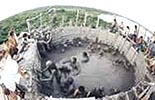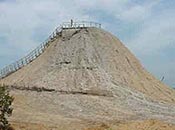 The
group consisted of the usual backpacker nationalities,
some Brits, Canadians, Australians, and two
Dutch girls. The agent seemed surprised at our
number, thirteen in all, but was confident that
we could all fit in to his four-wheel-drive
vehicle. In any number of other countries another
jeep would have been summoned, but we were in
the Caribbean coast of Colombia, where squeezing
the tourist for every last peso is an art form.
We did manage to get in, but myself and the
other Aussie had to stand at the rear clinging
onto the frame of the jeep's covering tarpaulin,
the wind whistling through our ears. The
group consisted of the usual backpacker nationalities,
some Brits, Canadians, Australians, and two
Dutch girls. The agent seemed surprised at our
number, thirteen in all, but was confident that
we could all fit in to his four-wheel-drive
vehicle. In any number of other countries another
jeep would have been summoned, but we were in
the Caribbean coast of Colombia, where squeezing
the tourist for every last peso is an art form.
We did manage to get in, but myself and the
other Aussie had to stand at the rear clinging
onto the frame of the jeep's covering tarpaulin,
the wind whistling through our ears.
The jeep sped at high speed through the streets
of Cartagena, and soon we were in open country.
After about 45 minutes we turned off the main
rod and headed up an unsealed track. Here a
moment's inattention nearly cost me my head
when the jeep cut through some low-hanging boughs.
After a short while, we crested a hill and a
strange vista came into view. At the foot of
the track, about two kilometers ahead, was a
large body of water, a freshwater lagoon of
some sort. Directly in front of it was a steep,
nical mound of earth, a bit like a giant ant-hill.
As we drew closer, the ant-hill took on surreal
appearance, like something out of a Indiana
Jones movie. It had a rickety wooden aircase
leading to its summit, which was about 20 meters
high. Its profile was incredibly eep. Just below
the summit you could see where planks had been
placed over a rupture the side of the cone.
The fresher mud that had bubbled out was a darker
colour, and rivulets they formed similarly to
wax dripping from a candle.
People had set up small restaurants and drink
stands, called kioskos. After we bought our
ticket at the wooden box-office, and changed
into our bathing costumes, our intrepid and
now intrigued group began the ascent; the whole
aim of the excursion was to "bathe" in the volcano.
 Peering
down into the "crater" of the cone was like
looking into a cauldron of boiling grey goo.
Every now and again, bubbles would surface,
slowly, because the mud was very viscous. So
viscous in fact that when you descended the
ladder on the inside edge of the crater, it
was impossible to fully submerge yourself unless
someone pushed you under. An attendant minded
our bags and cameras on the rim of the crater,
while another in the actual mud assisted us
in to the morass. The initial sensation was
one of floating in a thick, squishy warm bath.
Every few minutes a bubble would surface, ever
so slowly, and burst as it came to the surface,
with an evil burping sound. Peering
down into the "crater" of the cone was like
looking into a cauldron of boiling grey goo.
Every now and again, bubbles would surface,
slowly, because the mud was very viscous. So
viscous in fact that when you descended the
ladder on the inside edge of the crater, it
was impossible to fully submerge yourself unless
someone pushed you under. An attendant minded
our bags and cameras on the rim of the crater,
while another in the actual mud assisted us
in to the morass. The initial sensation was
one of floating in a thick, squishy warm bath.
Every few minutes a bubble would surface, ever
so slowly, and burst as it came to the surface,
with an evil burping sound.
There
is no fathomable bottom in the crater, but it
was impossible to drown in this 'bath', as the
specific gravity of the mud was much heavier
than water, so if you stood in the water you
floated only half submerged, from about your
belly-button down. The attendant recommended
that we cover our faces and hair with the goo;
it is said to be good for one's skin. Care must
be exercised not to get the mud in your ears
or eyes, however.
Soon
everyone looked like they were members of some
long-lost New Guinean tribe, and in this guise
males and females were indistinguishable, and
all races looked alike. The attendant on the
rim snapped photos for us. 'Swimming' in the
mud is tiring, because of the resistance the
mud offers your struggling limbs, and since
treading water is not necessary because it is
impossible to sink, it is best just to lie on
your back and float. As the mud dried in the
sun, it changed from a dark colour to the hue
of light grey cement, and flaked off your body
in chunks. One clowning Canadian in our group
dripped mud on his head, christening himself
'the blob' while an Israeli built up horns of
mud and would not have astray in a Vincent Price
film.
 A
Colombian family arrived after we had been in
a while, their infant was terrified of entering
the mud, screaming "No! No quiero!", but once
he was in the water he too was soon placated
and as happy as the proverbial pig in mud. Although
there is room enough for twenty people in the
crater, we took it as our cue to leave. All
mud was scraped off us by the attendant before
we left the crater, so as not to deplete its
reserve, but we still had a lot in our hair
and under our costumes. The guide then asked
us to follow him down to the lagoon, where some
young children were waiting to wash us, gesturing
to us to remove our costumes when in the water
(females were attended to by girls on the left,
men by boys 20 meters to the right). You could
wash yourself if you wanted to, but for most
of us it added another hilarious episode to
the day's events. I have never heard so many
people laughing while being scrubbed at one
time. They may have been young, but the children
were experienced washers, and had us clean in
a jiffy. A
Colombian family arrived after we had been in
a while, their infant was terrified of entering
the mud, screaming "No! No quiero!", but once
he was in the water he too was soon placated
and as happy as the proverbial pig in mud. Although
there is room enough for twenty people in the
crater, we took it as our cue to leave. All
mud was scraped off us by the attendant before
we left the crater, so as not to deplete its
reserve, but we still had a lot in our hair
and under our costumes. The guide then asked
us to follow him down to the lagoon, where some
young children were waiting to wash us, gesturing
to us to remove our costumes when in the water
(females were attended to by girls on the left,
men by boys 20 meters to the right). You could
wash yourself if you wanted to, but for most
of us it added another hilarious episode to
the day's events. I have never heard so many
people laughing while being scrubbed at one
time. They may have been young, but the children
were experienced washers, and had us clean in
a jiffy.
There
were storm clouds gathering, and before we could
make it back to the jeep we were caught in a
tropical downpour. It wasn't unpleasant however,
as it was a warm rain. Our guide told us that
the mud is produced from rotting vegetation
that originated under the lagoon and is forced
up through a fissure in the earth by volcanic
heat miles underground. In 1999 a nearby 'volcano'
unexpectedly erupted and spew forth a river
of mud that destroyed a village and killed one
man. There are several mud volcanoes in the
Cartagena area. The ones near Turbaco were first
described by Alexander von Humboldt in 1801;
they still exist though they are more pools
of mud than raised cones like the dramatic one
at Totumo.
The
trip back was not uneventful. Our jeep, lacking
a functioning windscreen-wiper on the driver's
side, wove its way back to Cartagena in pelting
rain in a manner that indicated the driver either
had divine help or some sort of radar......None
of we paassengers could see anything at all
through the front screen, yet the driver did
not go easy on the accelerator.
The
tour ended at La Boquilla. After a short but
heated argument among different beach-side restaurant
owners over who should get our custom, we sat
down under paraguas and tucked into sea-food
dishes. We were dropped back in our Cartagena
hotels by 4pm. The cost? A mere US$12, not including
lunch.
-
B A C K -
Text
and Photos Copyright 2005 Glen David Short |